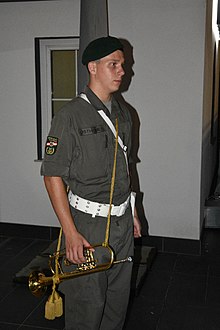Great Austrian tattoo
The Great Austrian Zapfenstreich is a ceremonial piece of music that was put together by Siegfried Somma in 1965 based on old Austrian drum calls and traditional marches on the occasion of the 600th anniversary of Tyrol's membership in Austria .
meaning
The piece of music is performed today on celebratory civil or military occasions such as large anniversaries or retirement and swearing-in by bands or the military music of the armed forces.
The Great Austrian Zapfenstreich has similarities to the Great Zapfenstreich known in Germany , mainly due to the sequence of certain pieces of music with the same purpose ( hymns and marches ).
Fixed components of the Great Austrian Zapfenstreich are the Austrian national anthem and the traditional march O du mein Österreich ; The respective national anthem and another traditional march can be inserted variably - usually the Radetzky march or a traditional march from the respective region is chosen.
History of origin
As in other European armies, the tattoo goes back to the time of the Thirty Years' War . Since the beginning of the 17th century, it has usually been used to indicate the night's sleep musically.
The sutler had to put a stop to the sociable carousing of the soldiers by knocking the spigot of the keg into it ("to strike") at a drum signal. This drum signal was later replaced by a horn signal, which - like all other signals of the k. u. k. Army - supposed to come from Michael Haydn .
Over time, the musical accompaniment of this military action for the night watch became a separate ceremony in which various pieces of military music were played. The ceremony of the Zapfenstreich appears for the first time in a regulation of the Infantry Regiment Graf von Lacy from the year 1769. Since then it has been common practice to play the “Great Zapfenstreich” in different versions in the Austrian army.
In 1853, for example, the Great Zapfenstreich, which is very similar to today's, with 13 infantry, 13 hunter and 11 cavalry bands under the personal direction of the then army bandmaster Andreas Leonhardt before Emperor Franz Joseph I , the Tsar Nicholas I , was held in Olomouc in 1853 , almost all archduke of the monarchy, the princes of Prussia, Bavaria and Württemberg and many domestic and foreign officers listed.
The Austrian Armed Forces have also resumed this tradition and carry out a major tattoo at military celebrations.
Course of the ceremony
The great tattoo of the Austrian Armed Forces is based on historical-traditional elements.
First part
The introduction depicts the field music with the camp guard, coming closer and closer from a distance, as it may have sounded around 1700. The drums, which began softly and got louder and louder, accompanied by the usual line-up of flutes, oboes, clarinets and trumpets, performed the “Zapfenstreich” from this period. A drum roll leads to the old Austrian horn signals "Habt Acht!", "Vergatterung", "Sturm!", "Acceleration" and "Attacke!"), Which are blown by two solo trumpeters. Then drummers strike the retreat, and the signal “Zapfenstreich” is performed in concert. Two traditional marches (“Prinz-Eugen-Marsch” by Andreas Leonhardt and “O du mein Österreich” by Ferdinand Preis / Trio by Franz von Suppè ) end the first part.
Second (military-religious) part
At the beginning the drummers strike the "prayer", then the orchestra plays the "Dutch thanksgiving prayer" . Now the signal “To prayer” sounds and the commander of the deployed troops orders “Have a look”. From a distance the solo trumpeter, accompanied by the orchestra, blows the “prayer”, after which the soldier's song “prayer before battle” is played. The commander orders “Parade rest” and from a distance the solo trumpeter blows the signal “Zapfenstreich”.
third part
A transition music, which is based on the opening bars of the national anthem, leads to the climax of the event: The commander of the disengaged troop commands: “Have eight”, “Present”, “Look to the right”. The national anthem and the European anthem will sound. The Austrian flag is brought down. After a fanfare and the “blow off” signal from the solo trumpeter, the orchestra ends this military-style evening music by “knocking off”. The commander of the deployed troops reports the termination and asks for further orders.
Web links
Individual evidence
- ↑ History on the website of the Armed Forces , accessed on November 23, 2015
- ^ Markus Haas: seminar paper. ( Memento of the original from November 23, 2015 in the Internet Archive ) Info: The archive link was inserted automatically and has not yet been checked. Please check the original and archive link according to the instructions and then remove this notice. (PDF) p. 8/9; accessed on November 23, 2015

